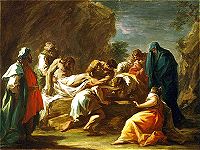 click to enlarge |
THE ENTOMBMENTGiovanni Antonio Pellegrini SN 176, oil on canvas, 1719 From: "The Pages" |
ARTIST:
With Sebastiano Ricci and Jacopo Amigoni, Pellegrini was the most important Venetian history painter of the early 18th c. By uniting the High Renaissance style of Paolo Veronese with the Baroque of Pietro da Cartona & Luca Giordano, he created graceful decorations that spread the Venetian style to Northern Europe. He traveled widely, working in Austria, England, the Netherlands, Germany, & France. His facile blends of the real and ideal at a dramatic moment brought him the steady patronage of the Catholic church. A great deal of his work was destroyed by bombardment in World War II.
Born in Venice in 1675, Pellegrini was the son of a glover. At an early age he was apprenticed to the Milanese Paolo Pagani (1661-1716). In 1696, Pellegrini was back in Venice where he painted his 1st surviving work, a fresco cycle in the Palazzetto Corner on Murano. In 1704 he married Angela, a sister of the pastelist Rosalba Carriera. He remained in close contact with his sister-in-law for the rest of his life,. Their correspondence leaves us an invaluable personal record. Pellegrini had traveled for most of his working years, but at 55 he returned to Venice for the remainder of his life.
He had an important collection of Dutch art, which after his death, was acquired by the English consul Joseph Smith.
SUBJECT:
The entombment of Christ is a traditional stage in church teachings of Christ’s life: Annunciation, birth and adoration, crucifixion, descent from the cross, and entombment. [Hale, Altar and Altarpiece.]
PAINTING:
Pellegrini painted with great speed and confident brushwork, achieving an overall effect of great natural-
ness, as if his were the true rendition of events. His pictorial techniques were theatrical, lighting
important details within a generally dark tonality (tenebrism), a technique used by followers of
Caravaggio. His use of foreshortening and perspective lends reality to the scene, pulling the viewer in.
In this painting he uses the foreshortened woman (on right) and the male figure’s turning toward Christ
as a device to engage the viewer. The serpentine patch of light on the floor serves the same purpose,
leading directly to Christ’s body.
HISTORIC CONTEXT:
In France Pellegrini won the competition to decorate the ceiling of the Mississippi Gallery, Banque Royale
Paris, with an elaborate allegory celebrating the financial scheme of John Law returning prosperity to France
after Louis XIV’s wars. The painting suggests Grand Opera – not unusual for Pellegrini. The Earl of
Manchester brought him to England, with S. Ricci, to paint operatic scenery for the Haymarket theater.
He also decorated a famous staircase in the Earl’s Kimbolton castle; his enchanting improvisations there
incorporated Venetian style and humor in dazzling trompe-l’oeil technique.
In England, Pellegrini’s friendships in aristocratic circles spread the popularity of Venetian art in the courts
of George III of England, Frederick the Great of Prussia, and Voltaire in France.
The symmetric balance of Pellegrini’s work hints at the coming Neoclassicism of Mengs.